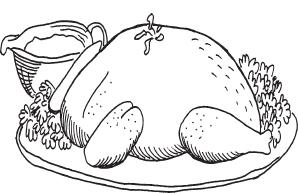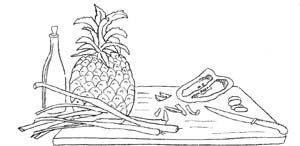Nourishing Traditions: The Cookbook That Challenges Politically Correct Nutrition and The... (83 page)
Authors: Sally Fallon,Pat Connolly,Phd. Mary G. Enig
Tags: #Non-Fiction, #Reference, #Science, #Health

THANKSGIVING DINNER
Coconut Turkey Soup
Celery Root Potato Puree
Pear Cranberry Pie
TURKEY STIR-FRY STEW
Serves 4-6
1½ pounds raw turkey, cut into small pieces
about 6 tablespoons extra virgin olive oil or lard
2 bunch green onions, sliced on an angle
1 green or red bell pepper, seeded and cut into a julienne
1 cup chopped pineapple, drained
1 small can water chestnuts, drained and sliced
2 cloves garlic, finely chopped
1 teaspoon grated ginger
½ teaspoon red pepper flakes
2 tablespoon naturally fermented soy sauce
1 tablespoon Rapadura (see
Guide to Natural Sweeteners
)1
/
8
cup rice vinegar2-3 cups
chicken
or
turkey stock2 tablespoons arrowroot mixed with 2 tablespoon filtered water
Mix stock with garlic, ginger, pepper flakes, soy sauce, Rapadura, and vinegar and set aside. Pat turkey pieces dry. In a heavy skillet or wok, saute turkey in batches in 3 tablespoons olive oil or lard until cooked through. Using a slotted spoon, transfer to a heated bowl. Add remaining olive oil or lard and saute onions and pepper about 2 minutes. Add sauce mixture and bring to a boil. Add cooked turkey, pineapple and water chestnuts to pan and mix well. Add arrowroot mixture and simmer a minute or so until sauce thickens. Serve with
basic brown rice
.
The first happy lesson gleaned from a study of traditional diets is that healthy food can and should taste good; that we can put butter on our porridge and cook in lard, that it's OK to consume whole milk, fatty meats, liver and onions, shrimp and lobster, even insects, if you like them; that heavenly sauces made from bone broth and cream confer more benefits than pills and powders and ersatz low-fat concoctions, the stepchildren of technology, pawned off as health foods.
Wisely used, technology can take the drudgery out of cooking, and help us bring properly grown and prepared foods to the marketplace. Wrongly used, technology produces breads that are soft and sweet rather than sour and chewy; coca-cola rather than cottage-industry lacto-fermented soft drinks; bouillon cubes rather than homemade broth; sugar-embalmed ketchup with infinite shelf life rather than enzyme-rich condiments and pickles preserved to last a few months in a way that adds nutrients, instead of taking them away.
The second lesson is that healthy eating is good for the ecology. The building blocks of a healthy diet are pesticide-free foods raised on mineral-rich soil, and healthy animals that live free to manure the paddocks of thousands of farms, rather than suffer in factories, confined to misery and disease. The road to health starts with a willingness to pay a good price for such food, thus rewarding the farmer who preserves the land through wise farming practices, rather than the agribusiness that mines the soil for quick profits.
Nasty, Brutish and Short?

PREPARATION OF WHOLE DUCK
Serves 8
2 whole ducks
juice of 4 lemons
Whole ducks are worth doing if you are willing to take a little time in preparation. Two ducks will yield 8 good servings. The carcasses and wings make a rich
duck stock
, and meat picked from the carcasses will be sufficient to make a meal of burritos or
enchiladas
. The livers make a delicious mousse (
Duck and Chicken Liver Mousse
) and the fat can be rendered and used for
frying potatoes
. The crispy pieces of fat produced by rendering are delicious on salads.Using a very sharp, flexible fish filleting knife, trim off neck fat and skin, the tail, and fat at the back of the cavity. Remove the wings and then the leg plus the thigh. Carefully remove the wishbone in the front of the carcass. Make a slit along the backbone, cut down along the rib cage and remove the breasts on both sides. Trim all the fat and skin off the carcass. Repeat the process with the second duck.
Trim excess fat off the four breasts and four thigh-leg pieces and marinate for several hours in fresh lemon juice; or marinate only the duck breasts and make preserved duck with legs and thighs (
Preserved Duck Legs
). Proceed with the following recipes or any of your own invention.
The record indicates that the incidence of tooth decay has increased as humans have increased the refined plant carbohydrate of their diet and lowered their intake of animal protein. During the paleolithic period, humans were largely meat eaters and consumed most of their plant foods as they found them; however, as long as humans used whole grains, the incidence of tooth decay remained low. For example, skeletal remains from Middle Age Denmark show about 6 percent of the total teeth with caries while other populations of Northern Europe approach a cavity rate of approximately 10 percent. As consumption of meat has decreased, and the consumption of grain foods and other carbohydrates (sugar and white flour) has formed a significant percentage of the diet, tooth decay has increased to epidemic proportions. H. Leon Abrams
Vegetarianism: An Anthropological/Nutritional Evaluation
It would be extraordinary if sugar and white flour, known to wreak havoc on the teeth, did not also have profound repercussions elsewhere in the body. Coronary disease has heretofore been regarded as a "complication" of diabetes. Both coronary disease and diabetes have a common cause: White sugar and white flour. William Dufty
Sugar Blues
DUCK FAT AND CRACKLINGS
To render duck fat and make cracklings, cut pieces of fat and skin into small chunks and place in a heavy-bottomed pan. Cook about ¾ hour over medium heat until all fat has been rendered and skin pieces turn golden brown. Remove cracklings with a slotted spoon to paper towels. Strain fat into a jar, cover tightly and store in the refrigerator. Cracklings are delicious French style
Caesar salad
. They should be stored in the refrigerator but heated gently before use.
It is not true. . .that the absolute length of life has lengthened. Actually, fewer persons alive at 70 today survive until 90 than 40 years ago. The lengthened life span of today is due to saving the lives of more babies and children. Edward Howell, MD
Food Enzymes for Health and Longevity
DUCK WITH GREEN PEPPER SAUCE
Serves 8
4 duck breasts and 4 thigh-leg pieces, marinated in lemon juice (see
Duck Fat and Cracklings
)3 cups
beef stock
or
duck stock½ cup dry white wine or vermouth
1 small can green peppercorns, drained, rinsed well and patted dry
1 cup
piima cream
or
creme fraichesea salt and pepper
Dry duck pieces with paper towels. Using a sharp knife, score the fat on the breasts and thighs. Cut the meat away from the underside of the thigh bone, open up and remove the thigh bone—this will facilitate browning. In a heavy-bottomed skillet, saute the breasts, two at a time, about 5 minutes per side. (Start by sauteing on the skin side, and the duck pieces will produce their own fat.) Remove to a heated platter. Pour out fat and saute the legs in the same manner. Pour out fat and add wine to the pan. Bring to a boil. Add stock and peppercorns and reduce to a simmer. Return the thigh pieces to the pan and simmer, uncovered, about 15 minutes. (Keep breast pieces in a warm oven—they should be medium rare or rare.) Remove leg pieces to heated platter, add cream to stock, bring liquid to a rapid boil and reduce to about 1 cup. Season to taste.
To serve, slice the breasts thinly and distribute to individual serving plates. Cut the leg from the thigh and place a leg or a thigh on each plate. Pour sauce over and serve immediately.
Variation: Duck Breasts with Green Pepper Sauce
Prepare recipe using
8 duck breasts
. Omit thighs.
The current medical theory is that a high-cholesterol diet causes high serum cholesterol which causes the atherosclerotic process. Although this theory appears to be correct, it isn't. . .. In the 1970's I started looking at patients' cholesterol levels and saw many which didn't fit the theory. Many who were big cholesterol eaters and had a good lipid profile and many who were not cholesterol eaters who had a poor lipid profile. I knew then that something was wrong with the dietary cholesterol theory. . .. I knew the real answer to the atherosclerotic process would be found by finding the cause of the initial injury to the intimal cells. I knew that all the theories of that injury had no scientific bases. In the early 1980's I suspected the oxidant free radical was the culprit. Finally in early 1987 I found the proof in the study of the exposure of guinea pigs to kerosene fumes. The liver increases the production of cholesterol in response to the injury to the intimal cells by oxidant free radicals. The cholesterol goes to the site of injury and itself becomes oxidized in an attempt to protect the cells. Roy W. Dowdell, MD
Health Freedom News
